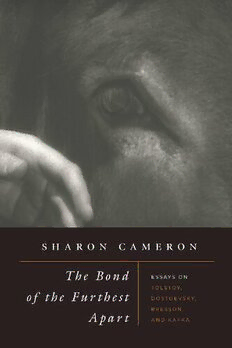
The Bond of the Furthest Apart: Essays on Tolstoy, Dostoevsky, Bresson, and Kafka PDF
Preview The Bond of the Furthest Apart: Essays on Tolstoy, Dostoevsky, Bresson, and Kafka
The Bond of the Furthest Apart The Bond of the Furthest Apart Essays on Tolstoy, Dostoevsky, Bresson, and Kafka sharon cameron The University of Chicago Press Chicago and London The University of Chicago Press, Chicago 60637 The University of Chicago Press, Ltd., London © 2017 by The University of Chicago All rights reserved. No part of this book may be used or reproduced in any manner whatsoever without written permission, except in the case of brief quotations in critical articles and reviews. For more information, contact the University of Chicago Press, 1427 East 60th Street, Chicago, IL 60637. Published 2017 Printed in the United States of America 26 25 24 23 22 21 20 19 18 17 1 2 3 4 5 isbn-1 3: 978- 0- 226- 41390- 7 (cloth) isbn-1 3: 978- 0- 226- 41406- 5 (paper) isbn-1 3: 978- 0- 226- 41423- 2 (e- book) doi: 10.7208/chicago/9780226414232.001.0001 Figure 2.1: Hans Holbein the Younger, The Dead Christ in the Tomb (1521- 22). Oil and tempera on lime wood, 32.4 × 202.1 cm. (acc. no. 318). Photograph: Kunstmuseum Basel. Photography by Martin P. Bühler. Library of Congress Cataloging- in- Publication Data Names: Cameron, Sharon, author. Title: The bond of the furthest apart : essays on Tolstoy, Dostoevsky, Bresson, and Kafka / Sharon Cameron. Description: Chicago ; London : The University of Chicago Press, 2017. | Includes bibliographical references and index. Identifiers: LCCN 2016034769 | isbn 9780226413907 (cloth : alk. paper) | isbn 9780226414065 (pbk. : alk. paper) | isbn 9780226414232 (e- book) Subjects: LCSH: Bresson, Robert— Criticism and interpretation. | Tolstoy, Leo, graf, 1828– 1910— Criticism and interpretation. | Dostoyevsky, Fyodor, 1821–1 881— Criticism and interpretation. | Kafka, Franz, 1883– 1924— Criticism and interpretation. Classification: LCC pn1998.3.b755 c35 2017 | ddc 809— dc23 LC record available at https://lccn.loc.gov/2016034769 ♾ This paper meets the requirements of ansi /niso z39.48-1 992 (Permanence of Paper). Contents List of Abbreviations vii Introduction 1 1 Animal Sentience: Robert Bresson’s Au hasard Balthazar 12 2 “Outside Christ”: Dostoevsky’s Joy 40 3 The Sight of Death in Tolstoy 75 4 Robert Bresson’s Pathos 119 5 Kafka’s No- Hope Spaces 168 Acknowledgments 199 Notes 201 Index 265 Abbreviations ag Leo Tolstoy, “Alyosha Gorshok” b Franz Kafka, “The Burrow” bk Fyodor Dostoevsky, The Brothers Karamazov cp Fyodor Dostoevsky, Crime and Punishment d Fyodor Dostoevsky, Demons dfk Franz Kafka, The Diaries of Franz Kafka, 1910– 1923 e Michel de Montaigne, The Complete Essays of Montaigne fc Leo Tolstoy, “The Forged Coupon” i Fyodor Dostoevsky, The Idiot i Franz Kafka, “Investigations of a Dog” ii Leo Tolstoy, “The Death of Ivan Ilych” im Franz Kafka, “An Imperial Message” l Leo Tolstoy, On Life lm Franz Kafka, Letters to Milena mm Leo Tolstoy, “Memoirs of a Madman” n Robert Bresson, Notes on the Cinematographer ss Franz Kafka, “The Silence of the Sirens” wp Leo Tolstoy, War and Peace Introduction The essays that follow can be read with an eye to a set of shared concerns, or they can be read separately; their coherence does not depend on a single argument. Nonetheless, recurrent, if uneven, connections dictate the logic of the essays’ collection in the same volume, which should be illuminated for the reader, who certainly deserves to know what the iconoclastic Catholic French filmmaker Robert Bresson (1901–1 999), recognized for his aesthetic of mini- malization and for the cultivation of automaticity and affectlessness in the nonprofessional actors he routinely called “models,” could have to do with the histrionics of the nineteenth- century Russian novelists Fyodor Dostoevsky and Leo Tolstoy, never mind with the cosmic hopelessness of the enigmatic creatures in the Czech Franz Kafka’s twentieth-c entury parables and stories. Of course Bresson filmed Dostoevsky and Tolstoy, though he insisted on the departure of his cinematography from its aesthetic origins: “Even if I make a film from Dostoevsky, I try always to take out all the literary parts. I try to go directly to the sentiments of the author and use only what can pass through me. I don’t want to make a film showing the work of Dostoevsky.”1 Bresson’s L’ Argent, which takes Tolstoy’s “The Forged Coupon” as its basis, transforms that story’s ending, thus revealing “what can pass through me” as in fact re- covering Tolstoy’s own earlier “sentiments.” Bresson might extract “the literary parts” of the novels he adapts, excising the language that anatomizes motive, intention, feeling— excluding whatever insinuates access to inwardness, since such access is precisely what Bresson in- sists cannot be signified or visualized.2 But he preserves the metamorphic, op- positional quality that informs Tolstoy’s and Dostoevsky’s writing. In Bresson’s films anything at all (one could therefore say everything) has an irreducible
